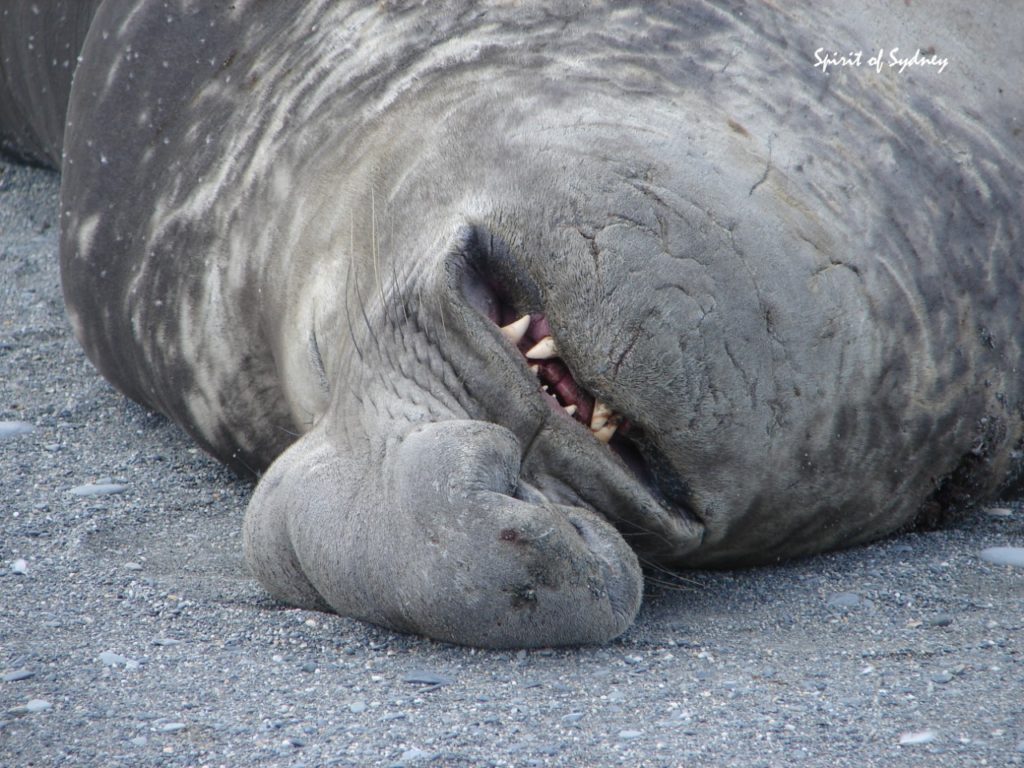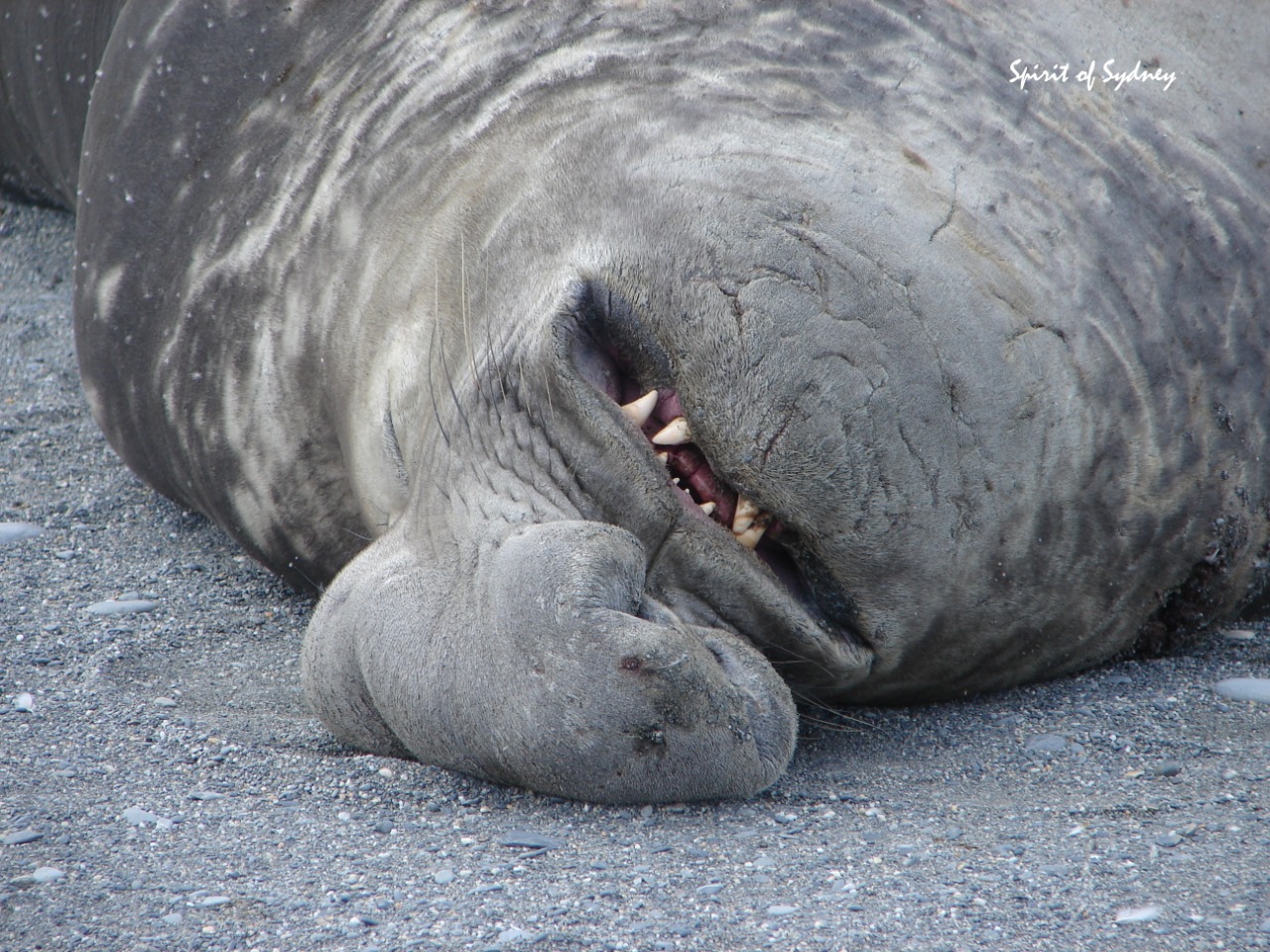
After almost 2 weeks, I am learning to speak South Georgian. The deep, resonating bass tone of the elephant seal males is easy – we hear it echoing across the water from over a mile away. It could be the resident beach master asserting their dominance or deterring a hopeful rival. Or maybe it’s a wanna-be, skulking on the outskirts of the harem, trying to sound powerful and threatening, testing the water before risking taking on the boss – so much to gain, so much to lose. I learn to recognise the high pitched yelp of the elephant seal pup, with some similarities to a baby dog. The female elephant seals make all sorts of noises reminiscent of burping and farting, sure to make a small child (and many an adult) snigger. I am often first alerted to a fur seal curled up nearby in tussock grass by a gentle hiss. “Hey, I’m here and you’re too close”. Some just sit there and follow me carefully with their eyes as I pass a bit further away, others are more aggressive, and the hiss turns to a deep growl. Sometimes we have to pass near to them and most of the time they run away if you bang stones together but a couple of times one has come towards me growling, with it’s teeth bared and my adrenaline has soared. We are here in October because in a month the beaches will be full of thousands of aggressive territorial fur seals, making safe landing almost impossible.
The birds are easy to learn in some ways – if we see a duck, it’s a pintail, all cormorants are the imperial blue-eyed shag, and a large gull is a kelp gull. They are the only one of their kind that survives – and thrives – here. We learn the short sharp chirp of the Arctic tern that flits over our heads and the monotone shrill of the kelp gull calling out from a rock. We know when we are near some nesting light mantled sooty albatross as we hear their distinctive cry from the sky above. It’s a sign to look up and search for them circling elegantly above, often in pairs. The pipit sings happily in the higher ground, it’s sweet melody more common on the island now that the invasive rats have been eradicated. Their recovery has been dramatic.
The ice too makes a noise, as we pass small bergy bits in the water we
can hear them gently hissing and popping – ancient air being released
and decompressed into the ocean as the ice melts. Occassionally there’s
a loud bang as a piece falls off a larger iceberg. In Gold Harbour, we
hear and then see a large icefall cascading down the cliffs from the
retreating glacier high up above.
The wind has been an almost constant companion, whistling through the
yacht rigging, sending the wind generators spinning wildly and leaning
the boat over in the strongest gusts. I read a description that the
notoriously fierce winds around Cape Horn continue unabated for over
1000 miles until they first slam into land in South Georgia. The tall
mountains and frigid glaciers create their own weather patters which
vary dramatically from one valley to the next. Just yesterday we enjoyed
a calm, sunny day of paddling 10 miles from St Andrews Bay around to
Royal Bay. The wind was less than 5 knots the entire day but in Royal
Bay, 50 knot gusts came swirling down from the glacier, creating 4 foot
waves and throwing sea spray up into the air. The yacht headed into the
bay first and warned us. They picked us up just before we reached the
wind tunnel. Our padding plans have changed more often than stayed the
same, due to the winds being much stronger than forecast and the sea
state around the exposed headlands being too wild and stormy.
We’ve camped a couple of nights. The first at Salisbury Plain and 2
nights ago at St Andrews Bay. We paddled 16 miles from Cobblers Cove on
a rare calm day, navigating through thick fog for the first 6 miles, the
sounds of waves crashing onto the base of cliffs a clue that we were
approaching land again after a crossing. The occasional mountain top
appeared through the haze to tease us, only to disappear again in the
murk. As we approached Ocean Harbour, the sun finally burns off the fog
and we have lunch by an old shipwreck and an elephant seal harem.
Arriving at St Andrews Bay, we gaze in amazement at over a mile of black
sand beach, almost entirely covered by elephant seals. It’s wall to wall
giant slugs, mostly inert with constant barking and yelping and burping
resonating around us. King penguins cover most of the snowy covered
plains behind the beach, and giant petrels., skuas and fur seals fill in
any gaps. We’ve seen a lot of elephant seals but this is like nothing
else. The other beaches were regional fighting competitions and this is
the big time. The males are huge and they show it by rearing up on their
hind quarters, squaring up to each other with open mouths. Sometimes
that’s enough and one male slinks away quickly, his muscle and blubber
rippling over the sand in quiet defeat. Other times, one male will hit
at the other one, slamming their bulk into their opponents neck or going
for a bite. The fights don’t last long. The loser seems to know quickly
that it’s best to save his strength.
We see many large males, sprawled out on the periphery of the harem with
bloody necks or deep cuts, resigned in their defeat. We see a lot of
bluff and bravado, and plenty of sneaky tactics. Rival males are never
far away from harems, sprawled innocently 5 or 10 metres away, trying to
act like they just happen to be taking a nap. If they inch a bit too
close, the beachmaster rises from his apparent slumber, powering his
several tonne bulk across the beach like a giant torpedo, crushing any
females or pups that don’t get out of the way in time.
I try to like the giant petrels that sit on the beach waiting for an
elephant seal to give birth so they can fight over the placenta. You can
tell the successful ones as they have blood over their face and beak.
They are almost as large and impressive as the albatross but their long
gangly wings somehow look clumsy and their large tube noses less elegant
than their close cousins. They are the ugly sister of the graceful
albatross, feeding on scraps while the albatross soars above and is much
more rarely seen. To be fair, albatrosses will also scavenge and it’s
causing their numbers to fall dramatically as they get caught on hooks
in long line fisheries. It’s chilling to see how few albatrosses are
nesting here compared to earlier years, we see 4 nesting wandering
albatross on Prion island, where there used to be thousands. It’s a very
real wake up call to buy albatross-friendly fish.
I love getting to feel the character of a new place and after almost 2
weeks in this very special wild and isolated island, I am starting to
speak the language and understand some of the nuances. There is so much
going on here on the sea and land that you could spend a lifetime here,
and still be learning.

